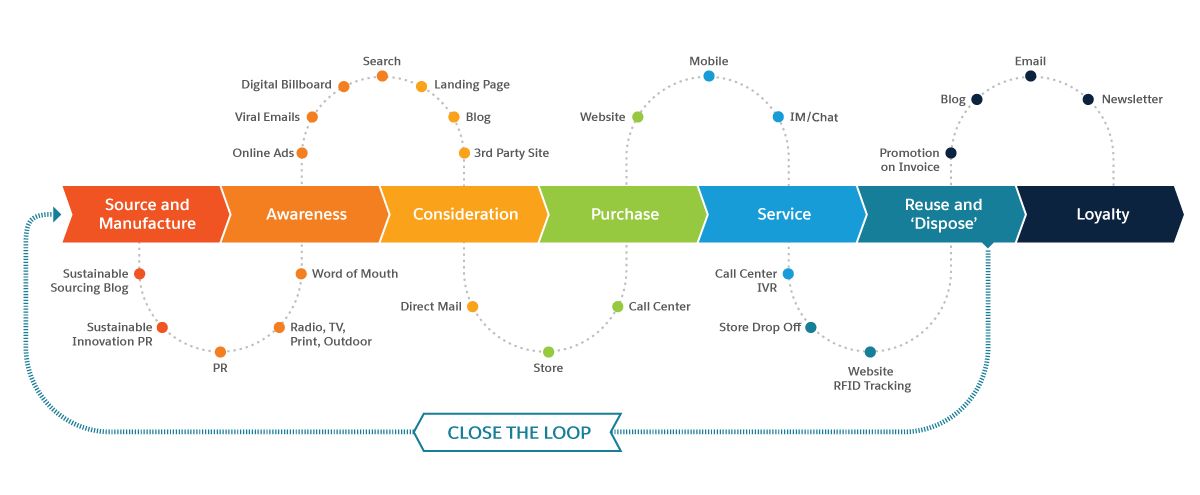Incorporate Sustainability from the Start
Learning Objectives
After completing this unit, you’ll be able to:
- Consider the materially important sustainability issues facing your industry.
- Include sustainable as key project criteria as you interview stakeholders.
- Incorporate sustainability questions into your design research.
- Widen the scope of your journey maps to include sustainability considerations.
Before You Start
Before you complete any units in this module, make sure you complete Sustainable Design. The work you do here builds on the concepts you learn there.
Bring Sustainability Front and Center
At any given time, only a few designers work on projects with sustainable design as a stated and central objective. Many are designing digital experiences or services seemingly removed from material products and their environmental and social impacts. It can seem like sustainable design is reserved for a future that hasn’t yet arrived.
But there are two things you can do immediately.
- First, get informed about your industry and its impacts. What you learn might surprise you.
- Second, include sustainability as a design parameter in your current project(s).
Adding sustainability as a strategic design parameter, or raising it as a topic for discussion, will always be relevant. The exercises in this module are practices that can help make this happen. Let’s start with how you do your research.
Get Informed About Your Industry
The sustainability issues that make a difference in cloud computing are different than those in agriculture, or transportation, or electronics, and so on. The impact of an industry and the risks posed by that impact are varied. In the language of sustainable design this is known as materiality. When designing sustainable solutions, it is important to understand what issues have the most material impact and strategic importance to your business. So it’s important to understand the material sustainability issues in your industry.
The Sustainability Accounting Standards Board (SASB) is an international NGO dedicated to improving industry-specific disclosure standards across environmental, social, and governance topics with financially material impacts. It has identified the sustainability issues likely to directly affect the financial performance of companies by industry. Check out SASB’s full, interactive Materiality Map™ when you’re doing your research. Here are some highlights.
Area of Impact |
Automobile |
Agriculture |
Apparel, Accessories, and Footwear |
Electric Utilities and Power Generation |
|---|---|---|---|---|
Environment |
Greenhouse gas (GHG) Emissions Energy Management Water & Wastewater Management |
GHG Emissions Air Quality Water & Wastewater Management Waste & Hazardous Materials Management |
||
Social and Human |
Product Quality & Safety Labor Practices |
Product Quality & Safety Employee Health & Safety |
Product Quality & Safety |
Access & Affordability Employee Health & Safety |
Business Model |
Product Design & Lifecycle Management Materials Sourcing & Efficiency |
Supply Chain Management Materials Sourcing & Efficiency |
Supply Chain Management Materials Sourcing & Efficiency |
Business Model Resilience |
Leadership and Governance |
Critical Incident Risk Management Systemic Risk Management |
The Materiality Map is a starting point for exploring sustainability within a given industry and can create a baseline level of knowledge on sustainability, which can sometimes seem insurmountably complex for teams who are inexperienced with the topic. Because the map focuses only on “financially material issues that are reasonably likely to impact the financial condition or operating performance of a company and therefore are most important to investors,” it also provides an implied prioritization of sustainability topics most likely to be concerning to executive teams.
As you begin a project, coming prepared with specific sustainability issues material to your industry will enable you to align sustainability design parameters with strategic concerns much more effectively than simply saying, “How can this be more sustainable?”
Ask Stakeholders About Sustainability
Stakeholder interviews set the table for the work to come. One simple way to incorporate sustainability into your work is to incorporate it right at the beginning by asking about it in your stakeholder interviews. They define the project objectives and the bounds within which you will be designing.
Major companies track the risks of climate change, think about their impact in society, and how they can be more meaningfully engaged in the communities they touch. However, it is rare to see those risk assessments meaningfully aligned with their core business. Stakeholder interviews make those connections right as a project starts.
 Include sustainability in strategic design criteria. Stakeholder interviews are an excellent place to add sustainability to your project's success criteria.
Include sustainability in strategic design criteria. Stakeholder interviews are an excellent place to add sustainability to your project's success criteria.
- First, include leaders focused on business functions such as sustainability, diversity and inclusion, ethics, and risk in your list of stakeholder interviews. If your client asks why, let them know the value proposition. Here is an example. "Today and in the future, innovation requires a broader definition of stakeholders. The companies who incorporate sustainability both reduce their exposure to risk and increase opportunities for business and brand value."
- Questions to ask these leaders:
- If you could describe your company’s past relationship to sustainability and corporate social responsibility as a set of phases or eras what would those phases/eras be? What phase are you in now? What’s coming next?
- What level of exposure does the company’s supply chain and brand reputation have to climate change and the global water crisis? How are you addressing those risks?
- What opportunities are you working on to align your company’s strategy to your work around sustainability? How might this project fit those goals?
- Beyond your customers and your shareholders, what other key stakeholders should we consider as we do this work?
Journey Maps: Broaden the Scope
A typical customer journey map starts with prepurchase and ends with purchase and use. One way to incorporate sustainability is to extend or broaden the scope of the journey even if it’s just a little. It starts with asking broader questions.
Let’s take a typical customer loyalty journey as an example. Typically, we start with customer awareness and pass through the traditional phases of consideration, purchase, service, and long-term loyalty. We think about how to leverage customer touchpoints and marketing channels all along this journey.
What if we extended and added phases and touchpoints to that journey and add opportunities to engage at sourcing and manufacturing, as well as after the normal life of a product?
 Extend your journey map: add opportunities to engage at sourcing and manufacturing, as well as after the normal life of a product
Extend your journey map: add opportunities to engage at sourcing and manufacturing, as well as after the normal life of a product
As always, the process starts with asking the right questions.
Prepurchase: The journey to the customer
-
Sourcing: Imagine that you’re designing dashboards for business users managing supply chains. Ask: For business users using our sourcing software to manage supply chains, can we reveal the impact of the sourcing decisions on the people, places, and ecosystems through which their supply chains run? Or: Dashboards reveal financial costs. Could they also include environmental or social costs? And: Who is impacted by these supply chains? Farmers? Transporters? Manufacturing workers? What can you do to improve our relationships with them?
-
Connecting to the source: And for the customer, how can we use communication channels to connect them with the source of our products and build engagement, excitement, and interest in not only our products but the partners and places in our supply chain?
-
Packaging: How can we minimize packaging?
-
Shipping: What’s the most efficient way to get the package where it needs to go? Who is the best partner to work with to manage the logistics responsibly?
Purchase: The buying journey
-
Opting out: Is there a sustainability choice that can be the default choice? Might customers opt out of that choice instead of being asked to opt in?
-
Transparency: How can the environmental impacts and benefits of a product be clearly understood during the decision-making process? or What is the environmental equivalent of a nutrition label?
Post-use: The journey after the customer
-
Extension and Reuse: Can the product’s life be extended in some way? Can it be reused?
-
Disposal: How will the product be disposed of? How would you design it to be as easily and effectively recycled as possible? Or what if it wasn’t disposed of at all, but instead returned and refurbished or repurposed?
-
Close the loop: Can we close the journey map loop and upcycle products as inputs into new product production?
This unit focuses on steps you can take during the research phase of your design work. In the next unit you learn about how you can question assumptions and design for impact.
